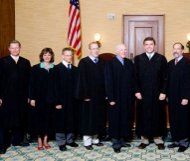6/23/2010
Oregon Appeals Court Throws Out DUI Eye TestOregon Appeals Court throws out common field sobriety test known as vertical gaze nystagmus.

The Oregon Court of Appeals earlier this month threw out a commonly performed roadside sobriety test as unscientific. A divided three-judge panel found the accuracy of vertical gaze nystagmus in establishing drunkenness remained unproven in the eyes of the court.
Curtis Wendell Bevan had passed through a laser speed trap in Umatilla County at an alleged 64 MPH in a 45 zone. Officer Gutierrez followed Bevan briefly and did not note any signs of erratic driving before pulling him over. Gutierrez did smell alcohol on Bevan's breath, and Bevan admitted drinking two beers -- the empty cans were still in the car. On this basis, Gutierrez administered a series of field sobriety tests.
Bevan failed the horizontal gaze nystagmus (HGN) test where he was asked to follow a penlight with his eyes as the light moved from side to side. When the eyes jerk involuntarily, that motion is known as "nystagmus" and is caused, according to Gutierrez, when an individual has consumed an excessive amount of alcohol or narcotics. Bevan "maintained his balance perfectly" on the one-leg-stand test and scored four out of eight on the walk-and-turn-test (higher than two is a failure). Gutierrez explained a final sobriety test during lower court proceedings.
"We did the vertical gaze nystagmus [VGN test], which instead of going side to side, I went up and down twice, and nystagmus was present in his eyes," Gutierrez explained.
Gutierrez arrested Bevan, who then refused to take a breath test. Two trained witnesses who interacted with Bevan during his arrest testified that, in their professional opinion, Bevan was not drunk and that Gutierrez had a bad attitude toward Bevan. Nonetheless, based on the vertical nystagmus test being presented as evidence as reliable as the horizontal nystagmus test, the jury convicted Bevan. The appeals court reversed.
"We reject the state's argument that the scientific principle underlying the VGN test has already been accepted by this state's appellate courts," Judge Darleen Ortega wrote for the majority. "Here, the scientific proposition underlying the evidence at issue is that there is a causal relationship between the consumption of alcohol in quantities greater than usual for the individual consumer and the type of nystagmus measured by the VGN test -- that is, jerking when the eyes move up and down. That proposition may be valid (although the record here does not establish its validity); however, it is not the same proposition that underlies the HGN test, nor is it a logical consequence of the scientific presumption underlying the HGN test."
Because the evidence was improperly admitted, the court found no alternative but to assume that this added evidence may have been enough to sway the jury toward a guilty verdict.
"Although there was other evidence that defendant was under the influence and Gutierrez's testimony about the VGN test was a relatively brief part of the evidence offered at trial, the prosecutor referred to the VGN evidence in the opening statement and closing argument, thus emphasizing the evidence for the jury's consideration," Ortega wrote. "Two of the jurors apparently voted against a guilty verdict based on a record that included the erroneously admitted testimony about the VGN test. Under the circumstances, we cannot say that there is little likelihood that the erroneous admission of the VGN evidence affected the jury's verdict."
A copy of the decision is available at the source link below.


